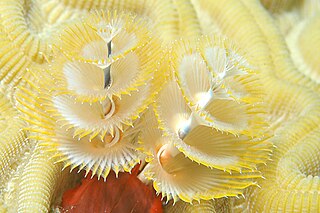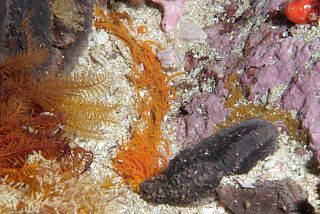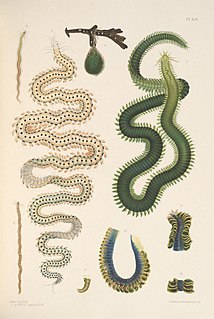
Nereis is a genus of polychaete worms in the family Nereididae. It comprises many species, most of which are marine. Nereis possess setae and parapodia for locomotion. They may have two types of setae, which are found on the parapodia. Acicular setae provide support. Locomotor chaetae are for crawling, and are the bristles that are visible on the exterior of the Polychaeta. They are cylindrical in shape, found not only in sandy areas, and they are adapted to burrow. They often cling to seagrass (posidonia) or other grass on rocks and sometimes gather in large groups. They are dangerous to touch giving very painful long lasting burns. Nereis worms are commonly known as rag worms or calm worms. The body is long, slender, and dorso-ventrally flattened, reaching a length of 5-30 cm. The head consists of two parts: a roughly triangular anterior lobe—the prostomium—and a posterior ring-like portion—the peristomium. The latter bears a pair of terminal tentacles, dorsally two pairs of eyes, and ventrally a pair of short two-jointed palps.

Aphrodita, or sea mouse, is a genus of marine polychaete worms found in the Mediterranean sea and the eastern and western Atlantic Ocean.

Spirobranchus is a small genus of tube-building annelid fanworms in the family Serpulidae.
Harmothoe is a genus of marine Polychaete worms belonging to the family Polynoidae. Species of Harmothoe are found world-wide to depths of at least 5,000 m but are more common in shallower water.

Phyllodoce is a genus of polychaete worms, which contains about 200 species. The prostomium bears eyes, two pairs of antennae and a pair of large retractile nuchal organs. The eversible proboscis is clearly divided into two parts.

Errantia, occasionally Aciculata, is a subclass of polychaete worms. These worms are found worldwide in marine environments and brackish water.

Diopatra is a genus of polychaete worms in the family Onuphidae.

Amphinomidae, also known as the bristle worms or sea mice, are a family of marine polychaetes, many species of which bear chaetae mineralized with carbonate. The best-known amphinomids are the fireworms, which can cause great pain if their toxin-coated chaetae are touched or trodden on. Their relationship to other polychaete groups is somewhat poorly resolved.

Cirriformia is a genus of marine polychaete worms in the family Cirratulidae.

Chloeia is a genus of marine polychaete worms.

Eulalia is a genus of polychaete worms.

Lepidasthenia is a genus of marine Polychaete worms belonging to the family Polynoidae. Species of Lepidasthenia are found world-wide to depths of about 1200 m but are more common in shallower water.

Eunoe is a genus of marine annelids in the family Polynoidae. The genus includes 48 species which are found world-wide, mostly from depths of 50 m or more.
Gattyana is a genus of marine annelids in the family Polynoidae. The genus includes 11 species, 9 of which occur in the northern hemisphere, the remaining two are from the Indian Ocean off Mozambique and the Southern Ocean off New Zealand. Species of Gattyana are known from shallow water down to depths of about 1200 m.
Hermadion is a genus of marine polychaete worms belonging to the family Polynoidae, the scaleworms. Hermadion contains a single species, Hermadion magalhaensi which is known from the South Atlantic, South Pacific and southern Indian Oceans at depths to about 110 m.
Hermadionella truncata is a scale worm known from the north-west Pacific and Arctic Oceans at depths down to about 200 m.
Neopolynoe is a genus of marine polychaete worms belonging to the family Polynoidae, the scaleworms. Neopolynoe contains 4 species, all known from the Atlantic Ocean from shallow water to depths of about 2500 m.
Neopolynoe acanellae is a scale worm known from the North Atlantic Ocean at depths about 400 to 2000 m.
Subadyte is a genus of marine polychaete worms belonging to the family Polynoidae, the scaleworms. Eight species of Subadyte are recognised and the genus is known to occur widely in the world's oceans from the intertidal zone to depths of about 1200 m.












